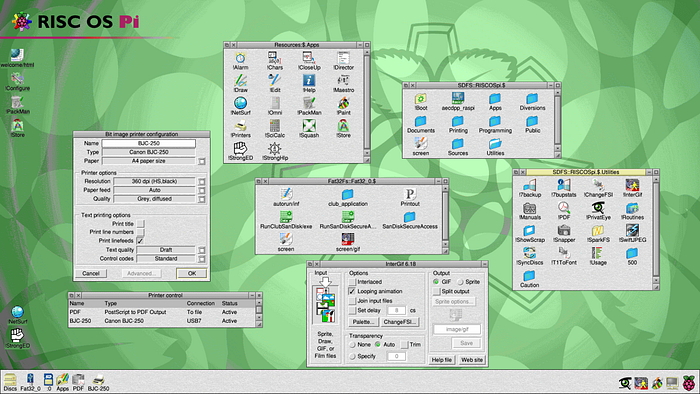RISC OS, is in a sense, the Operating System of my childhood. I'd used computers before it, 8 bit micros, even Macs, my school had many Mac Plus and Mac Classic models to play with, which were too expensive for most home users.
It was RISC OS on the Acorn Archimedes that really clicked for me though, when I first used an Acorn A5000, it just blew me away. It had a colour screen, a big one, nothing like the tiny black and white display in a Mac Classic. It had a hard disk and serious software installed, our Amiga at home had no hard disk, and we really only had games for it.

While the Amiga Workbench was quirky and charming, it just felt like it was about to fall apart any second, but the RISC OS desktop felt stable, coherent, and booted impossibly fast off ROM.
I had to have my own.
Savings were made, begging was done and in a few months an Acorn A3010 was sitting on a desk in our home.

This was a cheaper, slower alternative to the A5000, and I loved it. Over the months we saved for a hard disk, RAM upgrades (1MB to 4MB!), my brother and I used to write software and sell mail order.
Years passed and Acorn's fortunes rapidly diminished, fighting Apple and Microsoft at the same time, Acorn just couldn't sell enough computers to make it worthwhile, and even after making the sensational RiscPC computer, they just couldn't justify making more computers and stopped.
Thankfully, Acorn had a great many fans, and resellers who just didn't want to let the platform die, and Castle Technology released their own Acorn compatible computer in the form of the Iyonix:

Trapped in an anonymous PC case, it was unremarkable to behold, but it was a real, ARM-based RISC OS computer, with a 600MHz Xscale processor, it was far faster than anything Acorn ever made, and perhaps more importantly, brought RISC OS onto modern GPUs and the large screens they allow. RISC OS was available again to hobbyists.
The Iyonix served the Acorn market well, and perhaps kept the platform alive while we moved into the next era of RISC OS, the Raspberry Pi.
Thanks to the work done at Castle and other developments, RISC OS was no longer tied to Acorn hardware, and could run, with some effort, on many other ARM platforms. The explosive success of the Raspberry Pi made this an obvious target.

Now we could get brand new RISC OS computers for under $50.
Compared to Raspbian, RISC OS runs like lightning on even the oldest Raspberry Pi. The Pi's seemingly paltry amount of memory was more than any Acorn machine ever dreamed of. The ARM processor far in advance of anything Acorn ever made.
Using RISC OS today
Using RISC OS today is both a struggle and a pleasure. There is a noticeable lack of good web browsers, though this is changing with efforts to bring over a WebKit-based web browser.
Other areas are better served, PCloud is available for easily transferring files between your RISC OS machine and other devices. Text editing, drawing programs are available, and still maintained. You can program in Python, C, Lua, and some other languages.
RISC OS is unlikely to replace your Mac or Windows computer, but it is well worth a try if you have a Raspberry Pi. RISC OS has a delightful GUI which makes both my Mac and my Windows 10 computer feel heavyweight and interfering.
RISC OS developments continue today with OS updates and new hardware support arriving all the time. RISC OS is the best OS you've never heard of, and it is still around in 2020.
